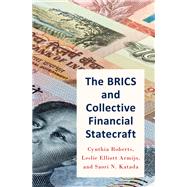- ISBN: 9780190697525 | 0190697520
- Cover: Paperback
- Copyright: 11/3/2017
Cynthia Roberts is Associate Professor of Political Science at Hunter College, CUNY; Senior Associate at the Saltzman Institute of War and Peace Studies and Adjunct Associate Professor of International Affairs at Columbia University. Her research focuses on the BRICS, international power shifts, and the liberal world order, and the strategies of major powers. She received her M.A., M.Phil. and Ph.D. from Columbia University and Certificate from the Harriman Institute.
Leslie Elliott Armijo teaches Political Economy and Development at the School for International Studies, Simon Fraser University, and has held Visiting Professorships in Brazil (2015) and Germany (2011). She investigates the politics of national and international economic policymaking, and their relationship to democratic consolidation, especially in Brazil, India, and large emerging economies. She holds degrees from Cornell University (B.A.) and the University of California, Berkeley (Ph.D).
Saori N. Katada is Associate Professor at School of International Relations at University of Southern California. Katada is the author of several books and numerous articles on trade, financial and monetary cooperation in East Asia and foreign aid. She has her Ph.D. from the University of North Carolina at Chapel Hill (Political Science) and B.A. from Hitotsubashi University (Tokyo). Before joining USC, she worked at the World Bank (Washington D.C.), and the UNDP (Mexico City).
1. Introduction: The BRICS as a Club
BRICS in the Aftermath of the Global Financial Crisis
Strategic Incentives in Unipolarity and Common Aversions
The BRICS and the Global Governance System
Formal Institutions and Informal Powers: The Emergence of Clubs
The BRICS as a Club
Clubs with Power Asymmetries and Dominant Powers with Outside Options
Plan of the Book
2. Global Power Shift: The BRICS, Building Capabilities for Influence
Conceptualizing Power
Measuring the Shift in Economic Capabilities
A New, Multipolar World?
The Global Financial and Monetary Capabilities of the BRICS
Redback Rising
Conclusions
3. BRICS Collective Financial Statecraft: Four Cases
Defining Collective Financial Statecraft
Four Categories of Collective Financial Statecraft
Inside Reforms: The BRICS Quest for Greater Influence Within the IMF and World Bank (Case 1)
Inside Reforms: Resist Manipulation of Financial Market Power for U.S./Western Political Aims (Case 2)
Outside Options: Create Parallel Financial Institutions Controlled by the BRICS (Case 3)
Outside Options: Diminish Dollar Dominance and Build the Financial Market
Power of the RMB (Case 4)
Future Directions and Cooperative Opportunities Not Taken
Conclusion: Mostly Successful BRICS Collective Financial Statecraft
4. Motives for BRICS Collaboration: Views from the Five Capitals
Six Propositions
The View from Beijing: In Search of Legitimacy and Unthreatening Leadership
The View from Moscow: Russia's Struggle for Autonomy and International Influence
The View from New Delhi: Amplifying Voice and Anticipating Multipolarity
The View from Brasília: Enhancing Status and Inviting Investment
The View from Pretoria: Support for Growth and Regional Leadership
Conclusions: Explaining BRICS Collaboration
5. Conclusion: Whither the BRICS?
BRICS and World Order: Too Much Pessimism Is Unwarranted
Growth: The Essential Need to Return to the BRICS' Roots
The Tension Between Formal and Informal Rules
Summing up: The BRICS, Collective Financial Statecraft, and the Multipolar Future
Notes
Index
The New copy of this book will include any supplemental materials advertised. Please check the title of the book to determine if it should include any access cards, study guides, lab manuals, CDs, etc.
The Used, Rental and eBook copies of this book are not guaranteed to include any supplemental materials. Typically, only the book itself is included. This is true even if the title states it includes any access cards, study guides, lab manuals, CDs, etc.
Digital License
You are licensing a digital product for a set duration. Durations are set forth in the product description, with "Lifetime" typically meaning five (5) years of online access and permanent download to a supported device. All licenses are non-transferable.
More details can be found here.






